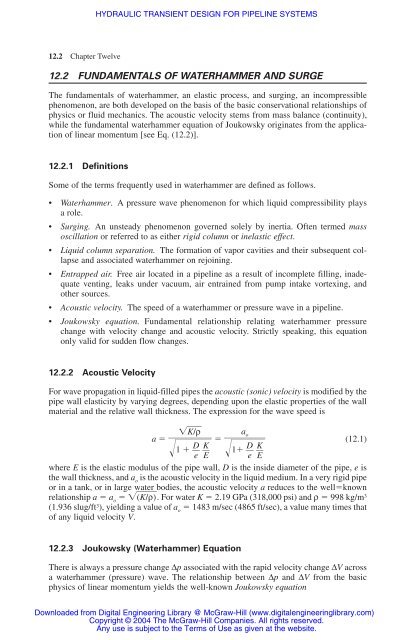chapter 12 hydraulic transient design for pipeline systems
chapter 12 hydraulic transient design for pipeline systems
chapter 12 hydraulic transient design for pipeline systems
You also want an ePaper? Increase the reach of your titles
YUMPU automatically turns print PDFs into web optimized ePapers that Google loves.
<strong>12</strong>.2 Chapter Twelve<br />
<strong>12</strong>.2 FUNDAMENTALS OF WATERHAMMER AND SURGE<br />
The fundamentals of waterhammer, an elastic process, and surging, an incompressible<br />
phenomenon, are both developed on the basis of the basic conservational relationships of<br />
physics or fluid mechanics. The acoustic velocity stems from mass balance (continuity),<br />
while the fundamental waterhammer equation of Joukowsky originates from the application<br />
of linear momentum [see Eq. (<strong>12</strong>.2)].<br />
<strong>12</strong>.2.1 Definitions<br />
HYDRAULIC TRANSIENT DESIGN FOR PIPELINE SYSTEMS<br />
Some of the terms frequently used in waterhammer are defined as follows.<br />
• Waterhammer. A pressure wave phenomenon <strong>for</strong> which liquid compressibility plays<br />
a role.<br />
• Surging. An unsteady phenomenon governed solely by inertia. Often termed mass<br />
oscillation or referred to as either rigid column or inelastic effect.<br />
• Liquid column separation. The <strong>for</strong>mation of vapor cavities and their subsequent collapse<br />
and associated waterhammer on rejoining.<br />
• Entrapped air. Free air located in a <strong>pipeline</strong> as a result of incomplete filling, inadequate<br />
venting, leaks under vacuum, air entrained from pump intake vortexing, and<br />
other sources.<br />
• Acoustic velocity. The speed of a waterhammer or pressure wave in a <strong>pipeline</strong>.<br />
• Joukowsky equation. Fundamental relationship relating waterhammer pressure<br />
change with velocity change and acoustic velocity. Strictly speaking, this equation<br />
only valid <strong>for</strong> sudden flow changes.<br />
<strong>12</strong>.2.2 Acoustic Velocity<br />
For wave propagation in liquid-filled pipes the acoustic (sonic) velocity is modified by the<br />
pipe wall elasticity by varying degrees, depending upon the elastic properties of the wall<br />
material and the relative wall thickness. The expression <strong>for</strong> the wave speed is<br />
a � � (<strong>12</strong>.1)<br />
where E is the elastic modulus of the pipe wall, D is the inside diameter of the pipe, e is<br />
the wall thickness, and ao is the acoustic velocity in the liquid medium. In a very rigid pipe<br />
or in a tank, or in large water bodies, the acoustic velocity a reduces to the well�known<br />
relationship a � ao � �(K�/ρ�)�. For water K � 2.19 GPa (318,000 psi) and ρ � 998 kg/m3 (1.936 slug/ft3 ��<br />
�1��� �<br />
), yielding a value of ao � 1483 m/sec (4865 ft/sec), a value many times that<br />
of any liquid velocity V.<br />
D<br />
����<br />
e<br />
K<br />
E ��<br />
�K�/ρ�<br />
��<br />
�1� �� � D<br />
����<br />
e<br />
K<br />
E ��<br />
<strong>12</strong>.2.3 Joukowsky (Waterhammer) Equation<br />
There is always a pressure change ∆p associated with the rapid velocity change ∆V across<br />
a waterhammer (pressure) wave. The relationship between ∆p and ∆V from the basic<br />
physics of linear momentum yields the well-known Joukowsky equation<br />
Downloaded from Digital Engineering Library @ McGraw-Hill (www.digitalengineeringlibrary.com)<br />
Copyright © 2004 The McGraw-Hill Companies. All rights reserved.<br />
Any use is subject to the Terms of Use as given at the website.<br />
a o
















